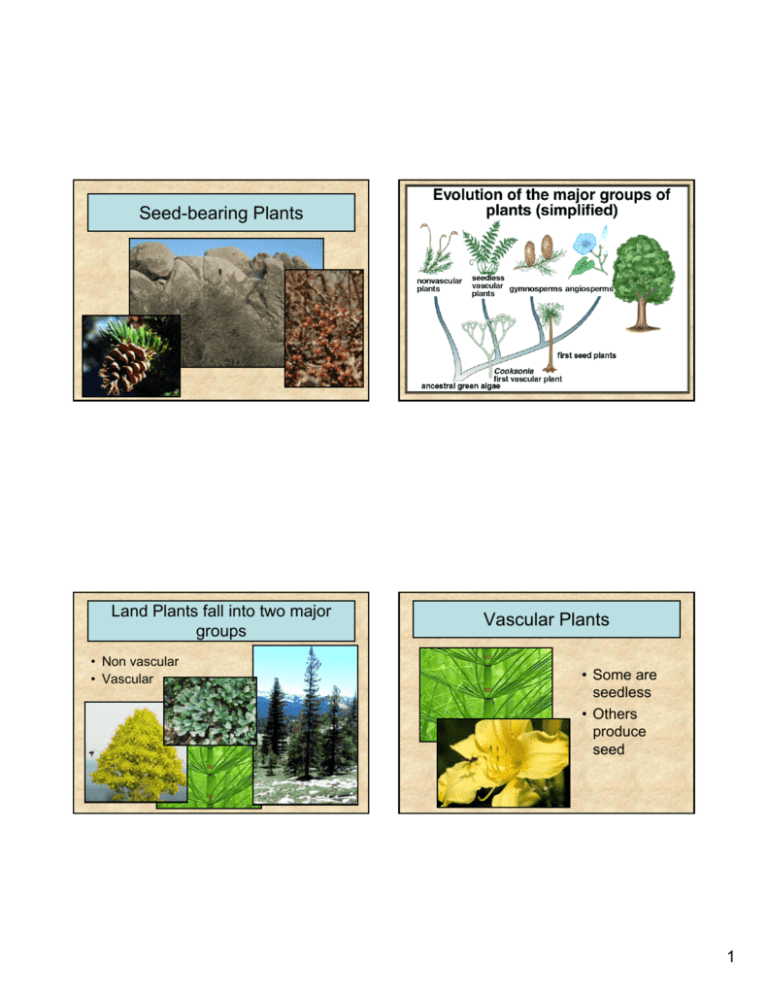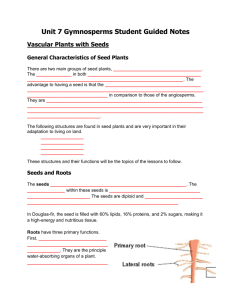Seed-bearing Plants Vascular Plants
advertisement

Seed-bearing Plants Land Plants fall into two major groups • Non vascular • Vascular Vascular Plants • Some are seedless • Others produce seed 1 Seed-bearing Vascular Plants fall into two major categories Seed-bearing Vascular Plants fall into two major categories • Gymnosperm – seeds naked on surface of sporophyll • Angiosperm – seeds enclosed in a ripened ovary Angiosperms Gymnosperms Seed-bearing plants also produce pollen Living Gymnosperms Cycads Conifers Ginkgoes Gnetophytes 2 Cycads Appeared on Earth 250 MYA • Reached their greatest abundance and diversity during the Jurassic • Declined sharply during the Cretaceous radiation of the angiosperms. Global Distribution of Cycads is Tropical Mexican Cycads Dioon Ceratozamia 3 Australian Cycads Macrozamia Macrozamia Only Cycad Native to the US Zamia pumila African Cycads Encephalartos Stangeria Cycads – Vegetative Characteristics Encephalartos in Africa 4 Cycad Stems • Columnar • Little branching • Not very woody Certain roots in Cycads grow toward the soil surface Corraloid Roots Cycad Leaves • Produced in crowns at tip of stem • Pinnately compound A Closer Look at Coralloid Roots • Grow upward near soil surface • Branch to form masses • Root cortex inhabited by Cyanobacteria (carry out nitrogen fixation) 5 Cycads produce pollen and seeds in cones Cycads – Reproductive Structures • Cones develop at apex of stem Many Cycads are Pollinated by Insects All Cycads are Dioecious • Individual plants produce either pollen cones or seed cones Trigona weevils • • • • Pollen Cone Seed Cone Cycas revoluta Only a few cycad species studied Weevils and oldest known bee genus (Trigona) Usually pollinators mate and lay eggs within female cone All cones except Stangeria produce heat. Thought to volatilize pollinator attractants • Hence insect pollination may predate flowering plants 6 Ginkgo – The Maiden Hair Tree Ginkgo was a common forest tree in the geological past • Today represented by a single species • Once occurred in North American Forests • Presently occurs naturally only in China Present Distribution of Ginkgo biloba Ginkgo is also widely cultivated • “Natural” trees may actually be plants cultivated at ancient Monasteries 7 Ginkgo – Vegetative Characteristics Ginkgo is Deciduous Ginkgo is Deciduous Ginkgo Stems • Extensive branching • Very woody 8 Ginkgo Stems Ginkgo Stems long shoot spur shoot long shoot spur shoot Ginkgo Leaves Leaf shape ranges from entire to bilobed • Fan shaped • Dichotomous branching veins 9 All Ginkgo trees are Dioecious • Individual plants produce either pollen “cones” or seed “cones” • Produced on spur shoots Ginkgo produces a seed with a fleshy seed coat • Seed Coat contains Butyric Acid • Seed Coat is not edible C Pollen “Cone” Seed “Cone” Ginkgo seeds are edible when fleshy seed coat is removed 10 Taro with Ginkgo Seed Ginkgo biloba leaves are a popular herbal remedy • Slow the progression of Alzheimer's symptoms • Relieve depression, anxiety, headaches, ringing in the ears (tinnitus), and dizziness • Reduce macular degeneration and control cataracts • Optimize brain power 11 Conifers – the most conspicuous gymnosperms Conifers • Like the Cycads and Ginkgos, Conifers are well represented in the fossil record Sequoia affinis Conifers are of great ecological importance • Conifers are the dominant members of the vast Boreal forests (Taiga) Conifers are of great ecological importance • Conifers are important members of other ecosystems 12 Conifers are of great economic importance • Edible Seeds • Crates, Boxes, Matchsticks, Furniture • Telephone Poles • Turpentine and Rosin (Resin) • Fuel (Pitch) • Pulpwood • Ornamentals • Pharmaceutica ls (Taxol) There are seven living families of Conifers Pines, Fir Spruce Norfolk Island Pines Five of the most familiar Sequoias and Redwoods Junipers and Cedars The Largest and the Oldest Plants are both Conifers Yew Vegetative Characters of Pine • Giant Sequoias of the California Sierras are the largest • Bristlecone pines of the California White Mountains are the oldest 13 Pine Stems • Extensive branching • Christmas tree shape • Very woody Pine Leaves • Needles produced in clusters (fascicles) of 1 to 5 Pine Stems • Wood consist of tracheids only • No fibers or vessels • Wood is “soft” Leaf shape in transverse section depends on number of leaves in the fascicle 14 Ginkgo Stems long shoot spur shoot Pine Leaves • Each fascicle is an entire spur shoot spur shoot long shoot Pine – Reproductive structures Pines produce pollen and seeds in cones 15 Pines are Monecious Pines are Monecious Individual plants produce both pollen cones and seed cones Individual plants produce both pollen cones and seed cones Pollen Cone Seed Cone C C Pollen cones produce pollen Seed cones produce seed Young seed cone C C Mature seed cone 16 The Gnetophytes Ephedra Ephedra is a desert shrub Gnetum Welwitschia Ephedra is distributed in arid regions of the world 50 species 39 species Ephedra contains Ephedrine monotypic http://www.anephedraattorneyforyou.com/ 17 Pseudoephedrine is a Synthetic Version of Ephedrine Gnetum occurs in the tropics 50 species 39 species Gnetum is a tropical vine or small tree Welwitschia is a bizarre plant of an extremely arid environment monotypic 18 Welwitschia occurs only in the Namib Desert in South-West Africa 50 species 39 species Welwitschia forms a short stem and deep tap root monotypic Welwitschia produces only two adult leaves Welwitschia leaves grow from the base – leaves fray as they grow 19











